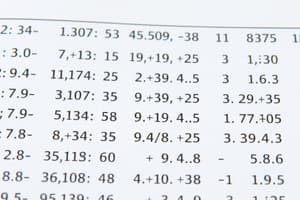Podcast
Questions and Answers
What is the conclusion if the P-value is between 0.0025 and 0.005 at a significance level of 5%?
What is the conclusion if the P-value is between 0.0025 and 0.005 at a significance level of 5%?
- Cannot reject the null hypothesis.
- Reject the null hypothesis with evidence for the alternative hypothesis. (correct)
- Indeterminate conclusion due to insufficient data.
- Accept the null hypothesis and conclude equal likelihood.
In the context of the chi-square goodness-of-fit test, what does a P-value greater than the significance level imply?
In the context of the chi-square goodness-of-fit test, what does a P-value greater than the significance level imply?
- There is not enough evidence to reject the null hypothesis. (correct)
- The results are statistically significant.
- The alternative hypothesis is supported.
- The sample distribution matches the null hypothesis.
What is the sample outcome in the example of the coin flip test?
What is the sample outcome in the example of the coin flip test?
- 168 heads and 232 tails (correct)
- 250 heads and 150 tails
- 180 heads and 220 tails
- 200 heads and 200 tails
Using the two-tailed test for a proportion based on normal distribution, what is the P-value calculated in the coin flip scenario?
Using the two-tailed test for a proportion based on normal distribution, what is the P-value calculated in the coin flip scenario?
At what significance level was the coin spinning test conducted?
At what significance level was the coin spinning test conducted?
What is the purpose of the Chi-square test for goodness of fit?
What is the purpose of the Chi-square test for goodness of fit?
What is the necessary condition for rejecting the null hypothesis in hypothesis testing?
What is the necessary condition for rejecting the null hypothesis in hypothesis testing?
How many steps are involved in carrying out a significance test using the Chi-square method?
How many steps are involved in carrying out a significance test using the Chi-square method?
What conclusion can be drawn if the evidence supports that local births are not equally likely on all days of the week?
What conclusion can be drawn if the evidence supports that local births are not equally likely on all days of the week?
In the context of the Chi-square test for goodness of fit, what does 'k' represent?
In the context of the Chi-square test for goodness of fit, what does 'k' represent?
What type of test is equivalent to the chi-square test for two categories?
What type of test is equivalent to the chi-square test for two categories?
If a sample shows a P-value of $0.0014$, what can be concluded regarding the hypothesis test at a significance level of 0.05?
If a sample shows a P-value of $0.0014$, what can be concluded regarding the hypothesis test at a significance level of 0.05?
What value indicates the degrees of freedom in the Chi-square goodness of fit test if k equals 7?
What value indicates the degrees of freedom in the Chi-square goodness of fit test if k equals 7?
What conclusion can be made if the Chi-square statistic value is high?
What conclusion can be made if the Chi-square statistic value is high?
In the birth example provided, what evidence was gathered regarding births across the week?
In the birth example provided, what evidence was gathered regarding births across the week?
What is the first step in carrying out a significance test?
What is the first step in carrying out a significance test?
If there are 700 births recorded, what is the expected count for each day if the distribution is even?
If there are 700 births recorded, what is the expected count for each day if the distribution is even?
What is the role of the P-value in the Chi-square test for goodness of fit?
What is the role of the P-value in the Chi-square test for goodness of fit?
What is the highest frequency of births recorded on a single day in the provided birth data?
What is the highest frequency of births recorded on a single day in the provided birth data?
Flashcards
P-value significance (0.0025-0.005)
P-value significance (0.0025-0.005)
When the p-value falls between 0.0025 and 0.005, the result is statistically significant, and we reject the null hypothesis in favor of the alternative.
Chi-square goodness-of-fit (P-value > significance level)
Chi-square goodness-of-fit (P-value > significance level)
When the p-value in a chi-square test is larger than the significance level, we fail to reject the null hypothesis, meaning there's insufficient evidence to change our assumption about the data distribution.
Coin flip sample outcome
Coin flip sample outcome
The observed result in the coin-flip experiment was 168 heads and 232 tails.
Two-tailed proportion P-value
Two-tailed proportion P-value
Signup and view all the flashcards
Coin spinning significance level
Coin spinning significance level
Signup and view all the flashcards
Chi-square goodness-of-fit purpose
Chi-square goodness-of-fit purpose
Signup and view all the flashcards
Reject null hypothesis condition
Reject null hypothesis condition
Signup and view all the flashcards
Chi-square test steps
Chi-square test steps
Signup and view all the flashcards
Unequal birth likelihood conclusion
Unequal birth likelihood conclusion
Signup and view all the flashcards
Chi-square 'k' definition
Chi-square 'k' definition
Signup and view all the flashcards
Chi-square equivalent test (2 categories)
Chi-square equivalent test (2 categories)
Signup and view all the flashcards
P-value (0.0014) conclusion (0.05 significance)
P-value (0.0014) conclusion (0.05 significance)
Signup and view all the flashcards
Degrees of freedom (k=7)
Degrees of freedom (k=7)
Signup and view all the flashcards
High Chi-square statistic conclusion
High Chi-square statistic conclusion
Signup and view all the flashcards
Birth data evidence
Birth data evidence
Signup and view all the flashcards
First step of significance test
First step of significance test
Signup and view all the flashcards
Expected count (700 births)
Expected count (700 births)
Signup and view all the flashcards
P-value role in Chi-square test
P-value role in Chi-square test
Signup and view all the flashcards
Highest birth frequency
Highest birth frequency
Signup and view all the flashcards
Study Notes
Chi-Square Test for Goodness of Fit
- Previously we tested if there is a relationship between two categorical variables - chi-square test for independence
- Now, we will test if a categorical variable has a specific distribution - chi-square test for goodness of fit
Steps of the Goodness of Fit Test
- State the null and alternative hypotheses
- Check conditions and calculate the test statistic
- Find the p-value using the appropriate distribution
- Make a decision and state a conclusion
Births Example
- The example looks at birth distribution across days of the week
- It is hypothesized that there are fewer births on the weekend
- A sample of 700 births was collected to test the hypothesis
Chi-Square Statistic
- The chi-square statistic is calculated based on the observed and expected frequencies
- The degrees of freedom are (k - 1) where k is the number of categories
Decision & Conclusion
- The decision is based on comparing the p-value and alpha (significance level)
- If the p-value is less than or equal to alpha, reject the null hypothesis
- If the p-value is greater than alpha, do not reject the null hypothesis
- The conclusion is stated in the context of the specific setting of the test
- For the birth example, the p-value was less than 0.05, so the null hypothesis was rejected - births were not equally likely on all days of the week
Comparison with a Two-Tailed z-Test for Two Categories
- The two-tailed z-test for proportions and the chi-square test for two categories are equivalent
- The coin spinning example tests if a coin has a 50-50 distribution of heads and tails
- Both methods, the z-test and the chi-square test, come to the same conclusion that the sample contradicts a 50-50 distribution
Studying That Suits You
Use AI to generate personalized quizzes and flashcards to suit your learning preferences.
Related Documents
Description
This quiz covers the Chi-Square Test for Goodness of Fit, focusing on how to state hypotheses, compute test statistics, and interpret p-values. An example involving birth distributions across the days of the week is provided for practical understanding.




